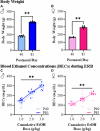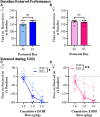A multicomponent ethanol response battery across a cumulative dose ethanol challenge reveals diminished adolescent rat ethanol responsivity relative to adults
- PMID: 38389807
- PMCID: PMC10880770
- DOI: 10.3389/adar.2023.11888
A multicomponent ethanol response battery across a cumulative dose ethanol challenge reveals diminished adolescent rat ethanol responsivity relative to adults
Abstract
Adolescence is a conserved developmental period associated with low alcohol responsivity, which can contribute to heavy drinking and development of an alcohol use disorder (AUD) later in life. To investigate ethanol responsivity between adolescent and adult rats, we developed an ethanol response battery (ERB) to assess acute ethanol responses across cumulative doses of ethanol during the rising phase of the blood ethanol curve. We tested the hypothesis that adolescent male and female rats would exhibit lower ethanol responsivity to a cumulative ethanol challenge relative to adults. Male and female adolescent (postnatal day [P]40) and adult (P85) Wistar rats underwent ERB assessment following consecutive doses of ethanol (i.e., 1.0, 1.0, and 1.0 g/kg) to produce cumulative ethanol doses of 0.0, 1.0, 2.0, and 3.0 g/kg. The ERB consisted of (1) the 6-point behavioral intoxication rating scale, (2) body temperature assessment, (3) tail blood collection, (4) accelerating rotarod assessment, (5) tilting plane assessment, and (6) loss of righting reflex (LORR) assessment. Across cumulative ethanol doses, adolescent and adult rats evidenced progressive changes in ERB measures. On the ERB, adolescent rats of both sexes evidenced (1) lower intoxication rating, (2) blunted hypothermic responses, particularly in females, (3) longer latencies to fall from the accelerating rotarod, and (4) less tilting plane impairment relative to adults despite comparable BECs. All adult rats, regardless of sex, displayed a LORR at the 3.0 g/kg cumulative ethanol dose while among the adolescent rats, only one male rat and no females showed the LORR. These data reveal decreased adolescent ethanol responsivity across body temperature, intoxication, balance, and coordination responses to a cumulative ethanol challenge as assessed using the novel ERB relative to adults. The results of this study suggest that adolescent-specific low ethanol responsivity may contribute to adolescent binge drinking and increased risk for development of an AUD.
Keywords: acute alcohol; adolescence; alcohol sensitivity; development; hypothermia.
Copyright © 2023 Vetreno, Campbell and Crews.
Conflict of interest statement
The authors declare that the research was conducted in the absence of any commercial or financial relationships that could be construed as a potential conflict of interest.
Figures







Similar articles
-
Chronic intermittent exposure to ethanol during adolescence produces tolerance to the hypnotic effects of ethanol in male rats: a dose-dependent analysis.Alcohol. 2008 Dec;42(8):617-21. doi: 10.1016/j.alcohol.2008.09.001. Alcohol. 2008. PMID: 19038695
-
Sex and age differences in heavy binge drinking and its effects on alcohol responsivity following abstinence.Pharmacol Biochem Behav. 2013 Mar;104:177-87. doi: 10.1016/j.pbb.2013.01.005. Epub 2013 Jan 16. Pharmacol Biochem Behav. 2013. PMID: 23333154 Free PMC article.
-
The effects of acute alcohol on motor impairments in adolescent, adult, and aged rats.Alcohol. 2015 Mar;49(2):121-6. doi: 10.1016/j.alcohol.2014.12.002. Epub 2014 Dec 24. Alcohol. 2015. PMID: 25613215
-
Social consequences of ethanol: Impact of age, stress, and prior history of ethanol exposure.Physiol Behav. 2015 Sep 1;148:145-50. doi: 10.1016/j.physbeh.2014.11.062. Epub 2014 Nov 26. Physiol Behav. 2015. PMID: 25431835 Free PMC article. Review.
-
Final report of the safety assessment of Alcohol Denat., including SD Alcohol 3-A, SD Alcohol 30, SD Alcohol 39, SD Alcohol 39-B, SD Alcohol 39-C, SD Alcohol 40, SD Alcohol 40-B, and SD Alcohol 40-C, and the denaturants, Quassin, Brucine Sulfate/Brucine, and Denatonium Benzoate.Int J Toxicol. 2008;27 Suppl 1:1-43. doi: 10.1080/10915810802032388. Int J Toxicol. 2008. PMID: 18569160 Review.
Cited by
-
β-arrestin-biased Allosteric Modulator of Neurotensin Receptor 1 Reduces Ethanol Drinking and Responses to Ethanol Administration in Rodents.bioRxiv [Preprint]. 2024 Apr 13:2024.04.10.588903. doi: 10.1101/2024.04.10.588903. bioRxiv. 2024. PMID: 38645173 Free PMC article. Preprint.
-
Recent Investigations Designed to Unravel the Interaction of Age and Alcohol on Behavior and Cognition: Potential Neurobiological Mechanisms.Adv Exp Med Biol. 2025;1473:243-256. doi: 10.1007/978-3-031-81908-7_11. Adv Exp Med Biol. 2025. PMID: 40128482 Review.
References
Grants and funding
LinkOut - more resources
Full Text Sources

